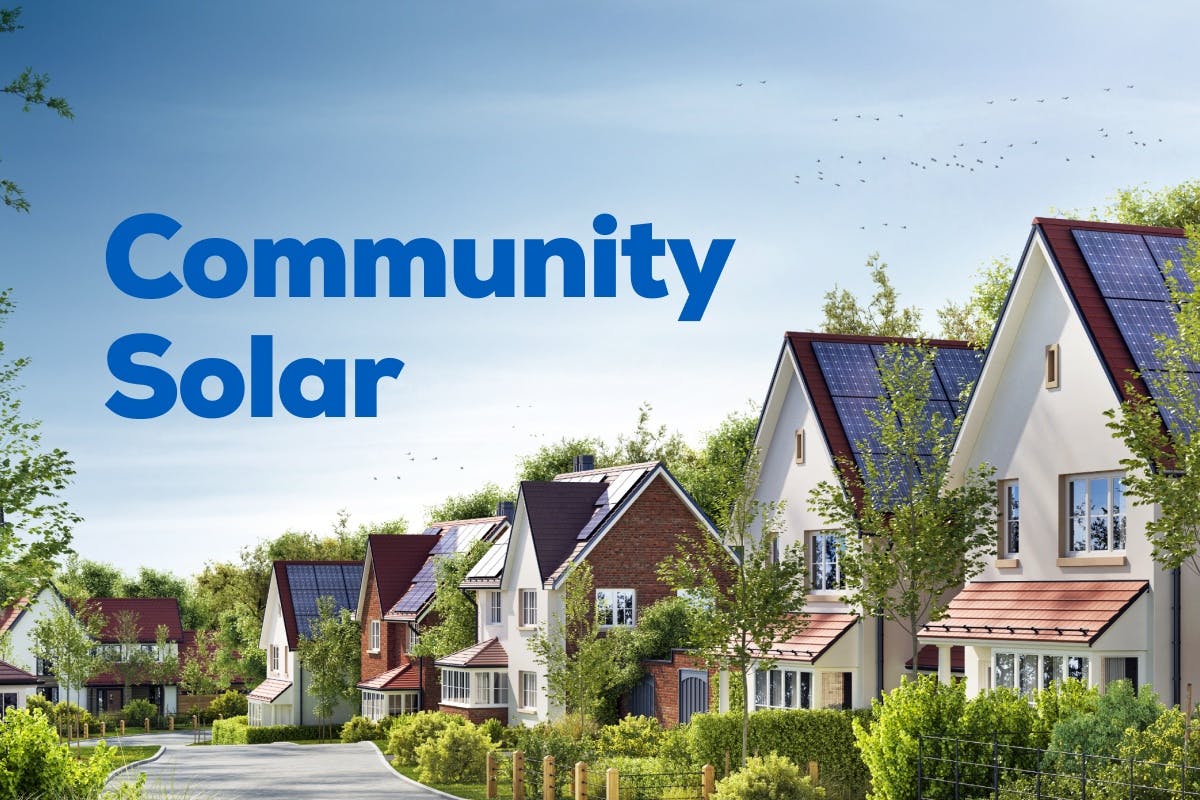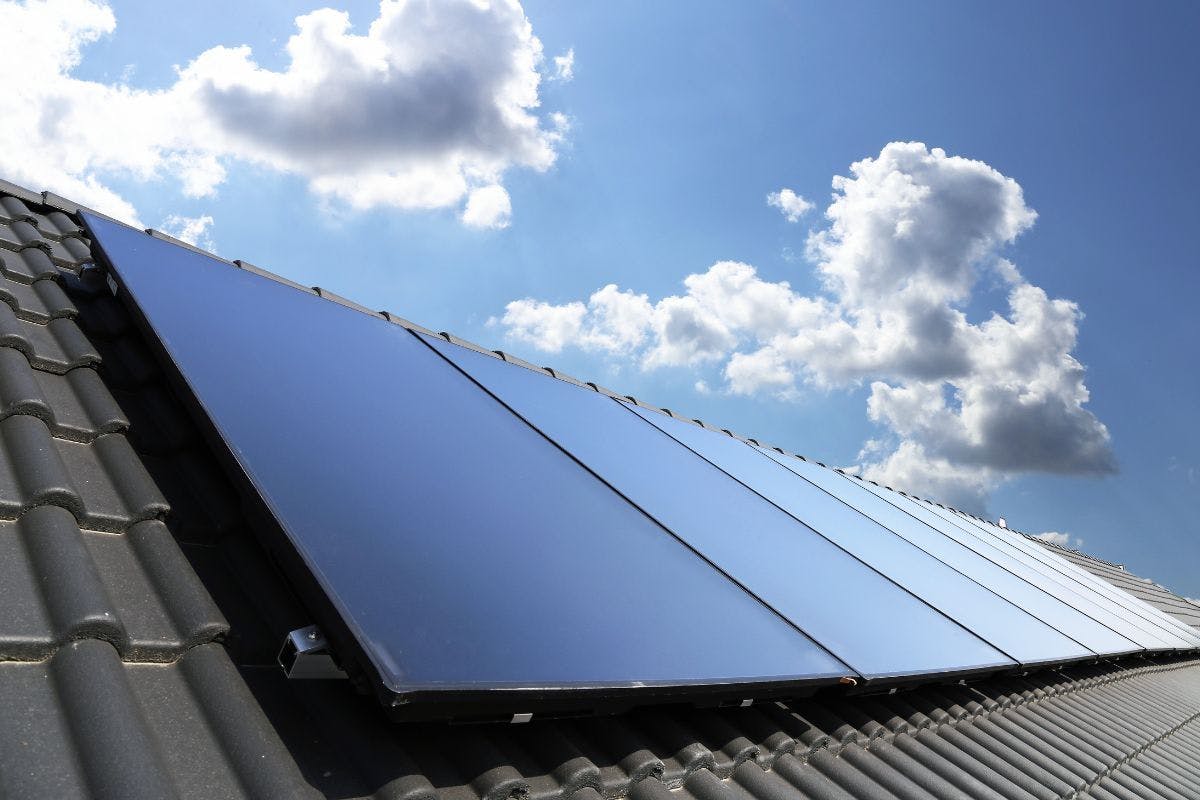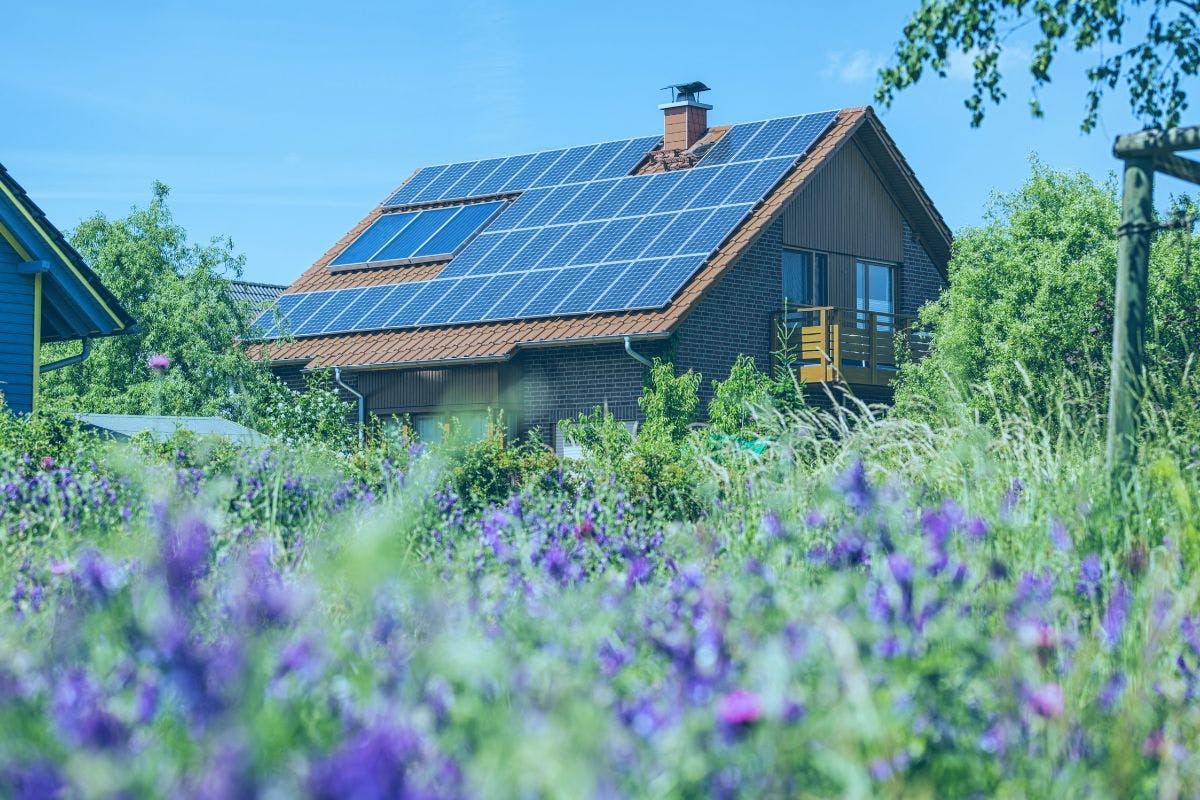What Are Community Solar, Community Choice Aggregation, and Green Energy Plans?
Actualizado

Autor
Andrew Giermak
Writer and Editor

Editor
Andrew Blok
Writer and Editor

You’ve looked into home solar panels, but your home isn’t a good fit for them.
In a growing number of areas of the US, community solar, community choice aggregation, and green energy plans may be the answer. If you can join one of these programs you can use solar power at home without the panels. You could save some money, too.
See how much you can save by going solar with Palmetto
What Is Community Solar?
As defined by the U.S. Department of Energy, community solar programs help multiple people enjoy the shared benefits of solar energy. They can join a shared solar project or purchasing program in their area.
Participants can include individuals, businesses, nonprofits, and others in the project area. Typically, the solar power is either generated at an off-site array or an on-site solar system that serves multiple families.
- Off-site array: The participants collectively buy or lease some of the solar panels in the array. They get a bill credit for the electricity generated by their solar panels and can use that credit to pay their utility bill.
- Centralized, multifamily systems: A more common solution for places like apartments or condominium complexes, all the occupants of the buildings will benefit from the energy produced by a centralized rooftop solar installation.
The National Renewable Energy Laboratory (NREL) has collected key statistics on the reach of community solar programs in the United States, as of June 2024.
- Community solar programs are active in 44 US states plus Washington, D.C.
- Community solar projects have more than 7,800 megawatts alternating-current (MW-AC) of capacity.
- About 73% of the community solar market is concentrated in four states: Florida (2,085 MW-AC), New York (1,764 MW-AC), Massachusetts (1,014 MW-AC), and Minnesota (910 MW-AC).
What Is Community Choice Aggregation?
Community choice aggregation (CCA) allows local governments to buy electricity on behalf of the residents in their geographic area to get a wholesale price. They are designed to offer the following benefits.
- Electricity at competitive prices
- Energy programs tailored to the needs of your community
- Local control by local community representatives
- Revenue reinvested into the community
- Supports local job creation with local energy projects
The “choice” part of community choice aggregation refers to choosing which energy resource the community will use for electricity. Common options include natural gas, nuclear, coal, or any form of renewable energy. The local government, potentially allied with other neighboring cities, will then buy electricity in bulk for the entire area to get electricity at a competitive price. While the government buys the electricity wholesale for its customers, investor-owned utilities will still transmit and distribute the electricity to those customers.
In regions with CCAs, strong community demand for clean energy can incentivize renewable energy development.
If you buy or rent a home in an area that has created a community choice aggregation program, you are automatically signed up for the program. You must opt-out if you don't want to participate.
The following states currently have areas with active community choice aggregation programs:
- California
- Illinois
- Maryland
- Massachusetts
- New Hampshire
- New Jersey
- New York
- Ohio
- Rhode Island
- Virginia
Here are some interesting stats about community choice aggregation:
- These programs have set several national green power and climate protection records, while still lowering power bills.
- CCA programs have received recognition from the NREL and Environmental Protection Agency for having more green power at a lower price than standard utility electricity.
- Several CCA programs in major US population centers have greener energy portfolios than local utilities, but don't charge a premium. This has led to the EPA giving them "green power leadership awards" for their achievement in renewable energy.
According to the Sierra Club, there are more than 180 cities and counties fully powered or committed to reach 100% powered by clean energy in the US.
See how much you can save by going solar with Palmetto
Community Solar vs. Community Choice Aggregation
Let’s compare community solar projects and community choice aggregation programs.
Similarities
- Both options serve a group of people rather than an individual.
- They can both support local renewable energy advancement. However, community solar is more likely to.
- Neither are available everywhere, so you have to research to see if these programs exist in your area.
Differences
- You don't have to buy or lease solar panels for community choice aggregation.
- Community choice aggregation typically has consolidated billing, while community solar often does not.
What Are Green Energy Plans?
Green energy is any electricity produced from a renewable energy source like wind, solar, biogas, geothermal, or low-impact small hydroelectric sources. (Compared to electricity produced by fossil fuels like coal and natural gas, which is definitely not green.) By signing up for a green energy electricity plan, people can choose to power their homes or businesses with clean energy without installing solar panels.
When you select a green power program from your utility company or retail electric provider, you give that company the money to buy a specific amount of electricity created exclusively from renewable energy. That green energy is then added to the larger utility grid. While it's not possible to guarantee your home will use that clean energy, you are helping to add to the overall amount of renewable energy available on the electric grid.
Check with the utility company in your area to see if it offers specialized green power options. If you live in an area with deregulated energy, you may be able to select a retail electric provider that offers green energy plans.
Understanding renewable energy credits
Green energy plans are powered by a concept called the renewable energy certificates (REC).
- One REC is the equivalent of 1,000 kilowatt-hours (kWh) or 1 Megawatt-hour (MWh) of electricity generated by 100% renewable energy sources.
- Each REC could be a combination of many different types of renewable energy, not just solar or wind.
- RECs are a way to incentivize utility companies and retail electric providers (REP) to invest in green power without necessarily building the infrastructure to generate renewable energy.
When someone chooses a green energy plan for their home or business, the energy company must purchase enough RECs to equal that consumer’s energy usage.
- Many states have created REC markets to encourage the increased development of green energy generation.
- With a regulated REC market, more people can make money off of investing in green energy.
- These markets allow utility companies and retail electric providers to purchase RECs to prove they have purchased green energy on behalf of their customers.
- Markets exist for Solar Renewable Energy Credits — RECs that are backed by 100% solar energy.
Green energy vs. clean energy
While many people think green energy and clean energy are the same, they do have some specific differences:
- Green energy refers to any energy from a natural source like sunlight, water, or wind, while clean energy is any energy source that produces negligible pollution, chemical contaminants, or greenhouse gases.
- Green energy is always renewable, while clean energy can be renewable but does not have to be.
Pros and Cons of Community Solar, Community Choice Aggregation, and Green Energy Plans
If you want to go solar in your home but you don’t have the opportunity to install solar panels, choosing any of these three options is a great path forward. However, each one does have certain pros and cons that might help you make your decision.
Pros and cons of community solar
Participants in community solar can benefit from the following:
- Powering your home with solar energy
- Shared maintenance of the solar panels
- Flexible options for power and plans
- Greater electricity rate stability
Community solar does have some downsides:
- Solar tax incentives are not available
- Not all states have community solar projects
Pros and cons of community choice aggregation
Community choice aggregation has significant positives:
- Lower energy costs than buying electricity on your own
- Helps your city choose to invest in renewable energy sources
- More transparency with local control
Disadvantages to community choice aggregation do exist:
- Level of clean energy depends on the details of the plan
Pros and cons of green energy plans
Choosing a green energy plan for your home has plenty of positives:
- Help companies invest in renewable energy
- Reduced carbon footprint
- Lower greenhouse gas emissions
- Support future clean power developments
Signing up for a green energy plan has negatives:
- REC and SREC market prices may decrease
- No guarantee rates are competitive with dirty electricity
Deciding Between Community Solar, Community Choice Aggregation, and Green Energy Plans
Depending on where you live, a community solar, community choice aggregation or green energy plan might be the best way to utilize solar or clean energy and save money on your utility expenses. At the same time, you will be helping the environment by using and supporting renewable energy.
In some areas of Texas, Palmetto’s Energy Plan and Battery Bonus Plan give customers 1-to-1 bill credits for solar energy they export to the electric grid. With the Energy Plan, customers get 100% renewable grid energy at times they don’t have solar power. With the Battery Bonus Plan, customers get an annual credit for having their battery power be used for grid balancing while having their own backup power.
If you want to install solar panels on your home to avoid rising energy prices, talk to Palmetto today. You can get started with our free solar savings calculator to see how much you can save by going solar.
See what solar can do for you:
Frequently Asked Questions
What is community choice aggregation?
Community choice aggregation programs allow a local government to buy electricity, from sources chosen by the public, at a wholesale price from a utility provider. A CCA program is meant to give a community lower energy prices, more control, and more local revenue and jobs.
What is community solar?
Community solar refers to a plan with local participants having a shared solar project or purchasing program for solar power. The solar power can come from an off-site or nearby array.
Are there downsides to community solar?
Potential drawbacks with community solar plans include limited availability. They may provide lower savings over time compared to purchasing panels, since community solar participants can’t claim solar incentives.


